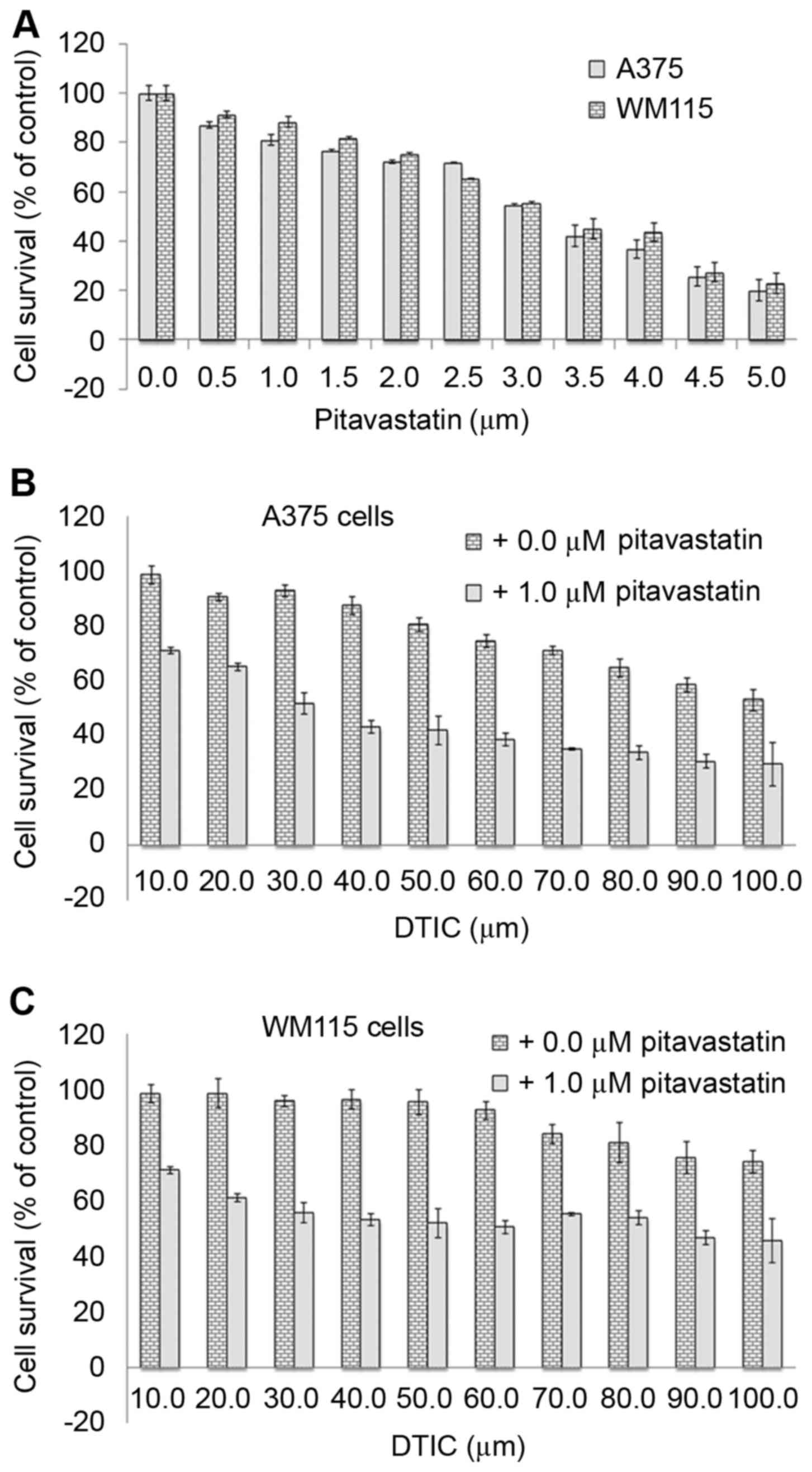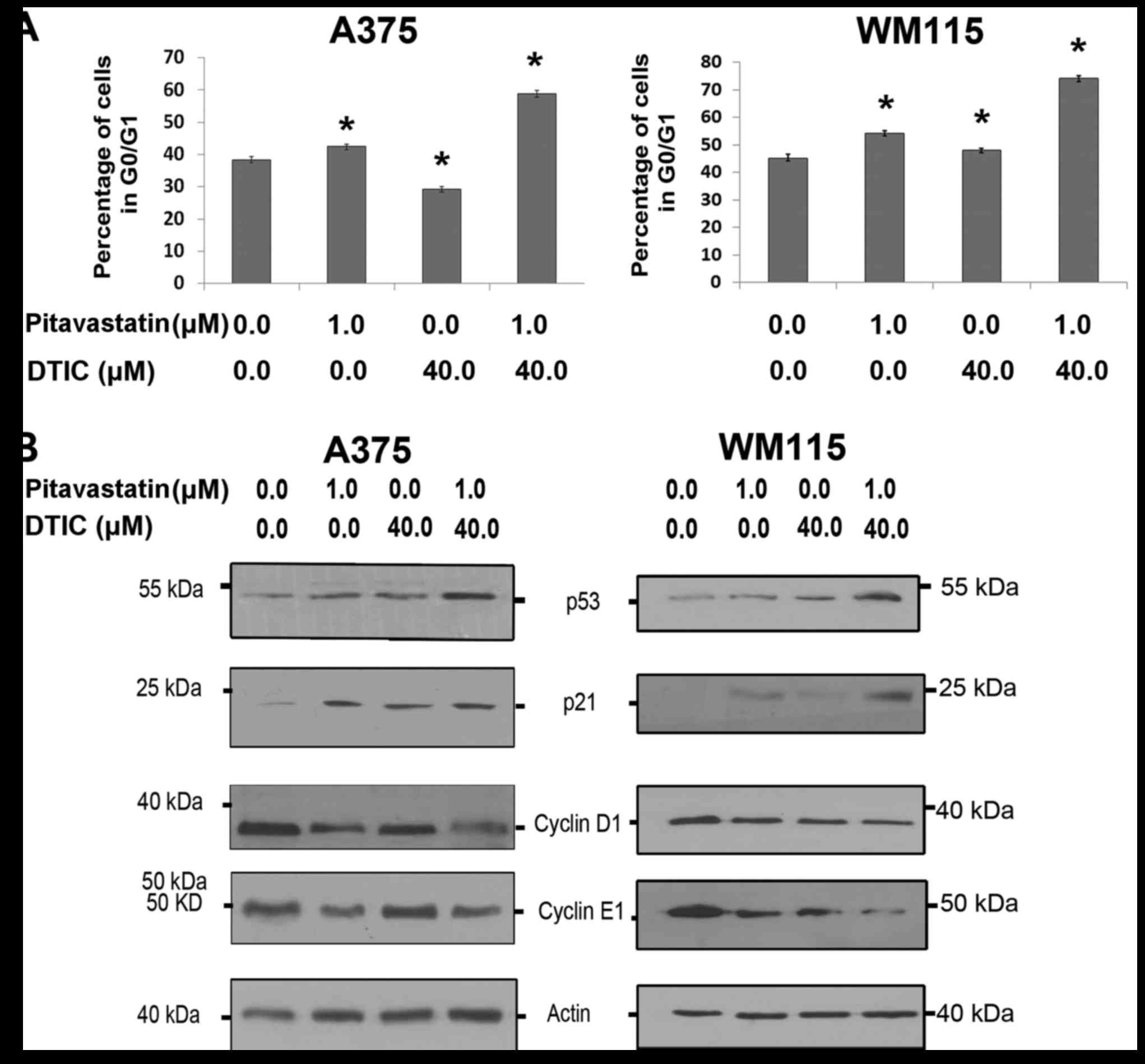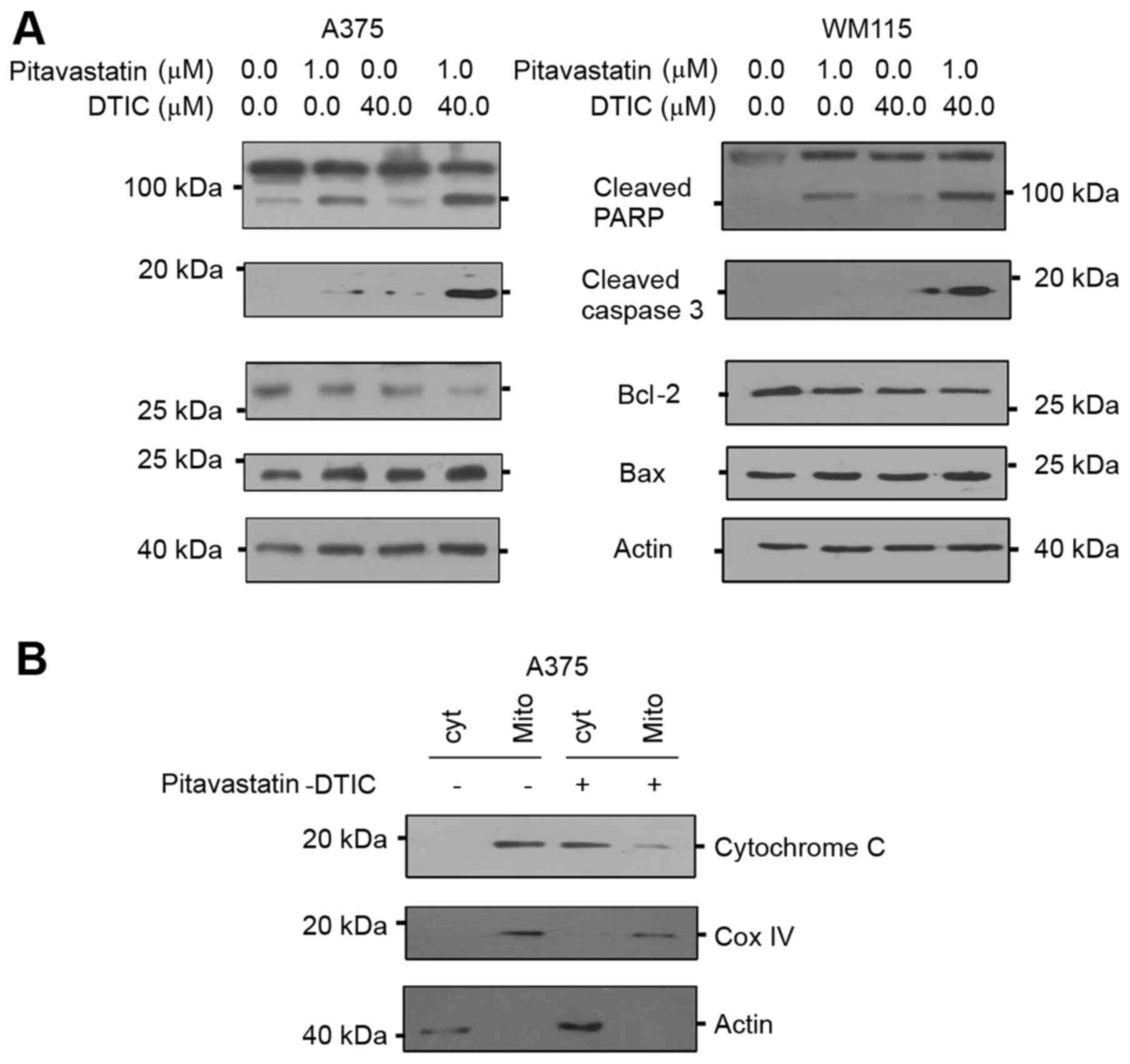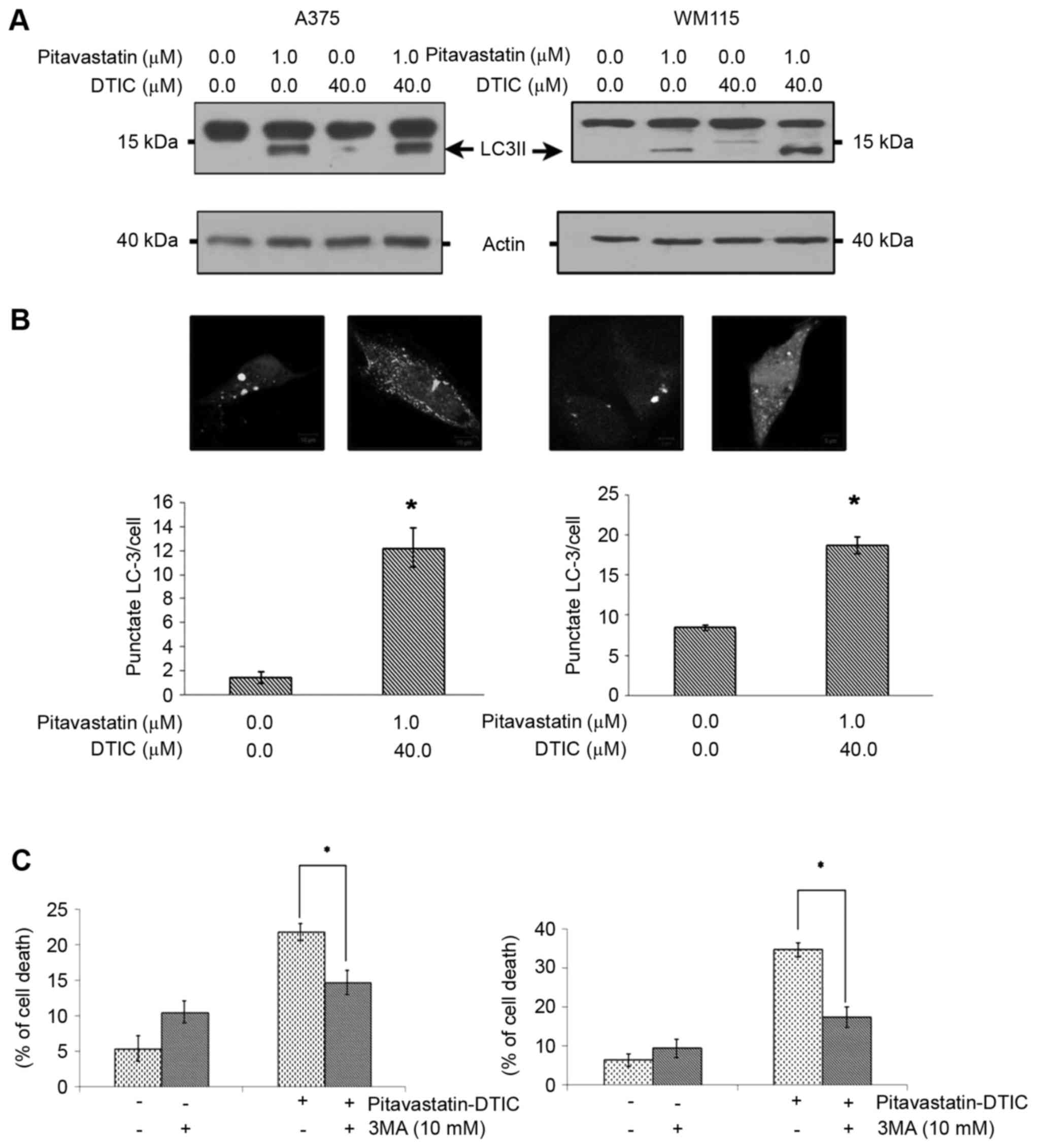|
1
|
Bhatia S, Tykodi SS and Thompson JA:
Treatment of metastatic melanoma: An overview. Oncology (Williston
Park). 23:488–496. 2009.PubMed/NCBI
|
|
2
|
Li W and Melton DW: Cisplatin regulates
the MAPK kinase pathway to induce increased expression of DNA
repair gene ERCC1 and increase melanoma chemoresistance. Oncogene.
31:2412–2422. 2012. View Article : Google Scholar : PubMed/NCBI
|
|
3
|
Lui P, Cashin R, Machado M, Hemels M,
Corey-Lisle PK and Einarson TR: Treatments for metastatic melanoma:
Synthesis of evidence from randomized trials. Cancer Treat Rev.
33:665–680. 2007. View Article : Google Scholar : PubMed/NCBI
|
|
4
|
Bedikian AY, Millward M, Pehamberger H,
Conry R, Gore M, Trefzer U, Pavlick AC, DeConti R, Hersh EM, Hersey
P, et al: Bcl-2 antisense (oblimersen sodium) plus dacarbazine in
patients with advanced melanoma: The Oblimersen Melanoma Study
Group. J Clin Oncol. 24:4738–4745. 2006. View Article : Google Scholar : PubMed/NCBI
|
|
5
|
Lev DC, Onn A, Melinkova VO, Miller C,
Stone V, Ruiz M, McGary EC, Ananthaswamy HN, Price JE and Bar-Eli
M: Exposure of melanoma cells to dacarbazine results in enhanced
tumor growth and metastasis in vivo. J Clin Oncol. 22:2092–2100.
2004. View Article : Google Scholar : PubMed/NCBI
|
|
6
|
Gopalan A, Yu W, Sanders BG and Kline K:
Simvastatin inhibition of mevalonate pathway induces apoptosis in
human breast cancer cells via activation of JNK/CHOP/DR5 signaling
pathway. Cancer Lett. 329:9–16. 2013. View Article : Google Scholar : PubMed/NCBI
|
|
7
|
Warita K, Warita T, Beckwitt CH, Schurdak
ME, Vazquez A, Wells A and Oltvai ZN: Statin-induced mevalonate
pathway inhibition attenuates the growth of mesenchymal-like cancer
cells that lack functional E-cadherin mediated cell cohesion. Sci
Rep. 4:75932014. View Article : Google Scholar : PubMed/NCBI
|
|
8
|
Simon A: Cholesterol metabolism and
immunity. N Engl J Med. 371:1933–1935. 2014. View Article : Google Scholar : PubMed/NCBI
|
|
9
|
Tu YS, Kang XL, Zhou JG, Lv XF, Tang YB
and Guan YY: Involvement of Chk1-Cdc25A-cyclin A/CDk2 pathway in
simvastatin induced S-phase cell cycle arrest and apoptosis in
multiple myeloma cells. Eur J Pharmacol. 670:356–364. 2011.
View Article : Google Scholar : PubMed/NCBI
|
|
10
|
Lee YP, Wang CW, Liao WC, Yang CR, Yeh CT,
Tsai CH, Yang CC and Tzeng YM: In vitro and in vivo anticancer
effects of mevalonate pathway modulation on human cancer cells.
Anticancer Res. 32:2735–2745. 2012.PubMed/NCBI
|
|
11
|
McFarland AJ, Anoopkumar-Dukie S, Arora
DS, Grant GD, McDermott CM, Perkins AV and Davey AK: Molecular
mechanisms underlying the effects of statins in the central nervous
system. Int J Mol Sci. 15:20607–20637. 2014. View Article : Google Scholar : PubMed/NCBI
|
|
12
|
Garwood ER, Kumar AS, Baehner FL, Moore
DH, Au A, Hylton N, Flowers CI, Garber J, Lesnikoski BA, Hwang ES,
et al: Fluvastatin reduces proliferation and increases apoptosis in
women with high grade breast cancer. Breast Cancer Res Treat.
119:137–144. 2010. View Article : Google Scholar : PubMed/NCBI
|
|
13
|
Wang J, Tokoro T, Higa S and Kitajima I:
Anti-inflammatory effect of pitavastatin on NF-kappaB activated by
TNF-alpha in hepatocellular carcinoma cells. Biol Pharm Bull.
29:634–639. 2006. View Article : Google Scholar : PubMed/NCBI
|
|
14
|
Fujino M, Miura S, Matsuo Y, Tanigawa H,
Kawamura A and Saku K: Pitavastatin-induced downregulation of CCR2
and CCR5 in monocytes is associated with the arrest of cell-cycle
in S phase. Atherosclerosis. 187:301–308. 2006. View Article : Google Scholar : PubMed/NCBI
|
|
15
|
Tsuboi Y, Kurimoto M, Nagai S, Hayakawa Y,
Kamiyama H, Hayashi N, Kitajima I and Endo S: Induction of
autophagic cell death and radiosensitization by the pharmacological
inhibition of nuclear factor-kappa B activation in human glioma
cell lines. J Neuosurg. 110:594–604. 2009. View Article : Google Scholar
|
|
16
|
Aliwaini S, Swarts AJ, Blanckenberg A,
Mapolie S and Prince S: A novel binuclear palladacycle complex
inhibits melanoma growth in vitro and in vivo through apoptosis and
autophagy. Biochem Pharmacol. 86:1650–1663. 2013. View Article : Google Scholar : PubMed/NCBI
|
|
17
|
Bagnoli M, Balladore E, Luison E, Alberti
P, Raspagliesi F, Marcomini B, Canevari S and Mezzanzanica D:
Sensitization of p53-mutated epithelial ovarian cancer to
CD95-mediated apoptosis is synergistically induced by cisplatin
pretreatment. Mol Cancer Ther. 6:762–772. 2007. View Article : Google Scholar : PubMed/NCBI
|
|
18
|
Fulda S and Debatin KM: Extrinsic versus
intrinsic apoptosis pathways in anticancer chemotherapy. Oncogene.
25:4798–4811. 2006.Bedia C, Casas J, Andrieu-Abadie N, Fabriàs G
and Levade T: Acid ceramidase expression modulates the sensitivity
of A375 melanoma cells to dacarbazine. J Biol Chem 286:
28200–28209, 2011. View Article : Google Scholar : PubMed/NCBI
|
|
19
|
Bedia C, Casas J, Andrieu-Abadie N,
Fabriàs G and Levade T: Acid ceramidase expression modulates the
sensitivity of A375 melanoma cells to dacarbazine. J Biol Chem.
286:28200–28209. 2011.Kim YJ, Brox T, Feiden W and Weickert J:
Fully automated segmentation and morphometrical analysis of muscle
fiber images. Cytometry A 71: 8–15, 2007. View Article : Google Scholar : PubMed/NCBI
|
|
20
|
Kim YJ, Brox T, Feiden W and Weickert J:
Fully automated segmentation and morphometrical analysis of muscle
fiber images. Cytometry A. 71:8–15. 2007. View Article : Google Scholar : PubMed/NCBI
|
|
21
|
Fulda S and Debatin KM: Extrinsic versus
intrinsic apoptosis pathways in anticancer chemotherapy. Oncogene.
25:4798–4811. 2006. View Article : Google Scholar : PubMed/NCBI
|
|
22
|
Ghatage DD, Gosavi SR, Ganvir SM and
Hazarey VK: Apoptosis: Molecular mechanism. J Orofac Sci.
4:103–107. 2012. View Article : Google Scholar
|
|
23
|
Surova O and Zhivotovsky B: Various modes
of cell death induced by DNA damage. Oncogene. 32:3789–3797. 2013.
View Article : Google Scholar : PubMed/NCBI
|
|
24
|
Kang MH and Reynolds CP: Bcl-2 inhibitors:
Targeting mitochondrial apoptotic pathways in cancer therapy. Clin
Cancer Res. 15:1126–1132. 2009. View Article : Google Scholar : PubMed/NCBI
|
|
25
|
Yang ZJ, Chee CE, Huang S and Sinicrope
FA: The role of autophagy in cancer: Therapeutic implications. Mol
Cancer Ther. 10:1533–1534. 2011. View Article : Google Scholar : PubMed/NCBI
|
|
26
|
Tomic T, Botton T, Cerezo M, Robert G,
Luciano F, Puissant A, Gounon P, Allegra M, Bertolotto C, Bereder
JM, et al: Metformin inhibits melanoma development through
autophagy and apoptosis mechanisms. Cell Death Dis. 2:e1992011.
View Article : Google Scholar : PubMed/NCBI
|
|
27
|
Zeng Y, Yang X, Wang J, Fan J, Kong Q and
Yu X: Aristolochic acid I induced autophagy extenuates cell
apoptosis via ERK 1/2 pathway in renal tubular epithelial cells.
PLoS One. 7:e303122012. View Article : Google Scholar : PubMed/NCBI
|
|
28
|
Patel PM, Suciu S, Mortier L, Kruit WH,
Robert C, Schadendorf D, Trefzer U, Punt CJ, Dummer R, Davidson N,
et al: Extended schedule, escalated dose temozolomide versus
dacarbazine in stage IV melanoma: Final results of a randomised
phase III study (EORTC 18032). Eur J Cancer. 47:1476–1483. 2011.
View Article : Google Scholar : PubMed/NCBI
|
|
29
|
Risberg K, Fodstad O and Andersson Y:
Anti-melanoma activity of the 9.2.27PE immunotoxin in dacarbazine
resistant cells. J Immunother. 33:272–278. 2010. View Article : Google Scholar : PubMed/NCBI
|
|
30
|
Fuller TL and Canada RG: Enhancement of
cisplatin cytotoxicity by terbium in cisplatin-resistant MDA/CH
human breast cancer cells. Cancer Chemother Pharmacol. 44:249–252.
1999. View Article : Google Scholar : PubMed/NCBI
|
|
31
|
Yang PM and Chen CC: Life or death?
Autophagy in anticancer therapies with statins and histone
deacetylase inhibitors. Autophagy. 7:107–108. 2011. View Article : Google Scholar : PubMed/NCBI
|
|
32
|
Jin JL, Gong J, Yin TJ, Lu YJ, Xia JJ, Xie
YY, Di Y, He L, Guo JL, Sun J, et al: PTD4-apoptin protein and
dacarbazine show a synergistic antitumor effect on B16-F1 melanoma
in vitro and in vivo. Eur J Pharmacol. 654:17–25. 2011. View Article : Google Scholar : PubMed/NCBI
|
|
33
|
Sanada M, Hidaka M, Takagi Y, Takano TY,
Nakatsu Y, Tsuzuki T and Sekiguchi M: Modes of actions of two types
of anti-neoplastic drugs, dacarbazine and ACNU, to induce
apoptosis. Carcinogenesis. 28:2657–2663. 2007. View Article : Google Scholar : PubMed/NCBI
|
|
34
|
Cun B, Song X, Jia R, Zhao X, Wang H, Ge S
and Fan X: Combination of oncolytic adenovirus and dacarbazine
enhances antitumor ability against uveal melanoma cells via cell
cycle block. Cancer Biol Ther. 13:77–84. 2012. View Article : Google Scholar : PubMed/NCBI
|
|
35
|
Koprowska K, Hartman ML, Sztiller-Sikorska
M and Czyz ME: Parthenolide enhances dacarbazine activity against
melanoma cells. Cancer Biol. 24:835–845. 2013.
|
|
36
|
Ishibashi M, Arai M, Tanaka S, Onda K and
Hirano T: Antiproliferative and apoptosis-inducing effects of
lipophilic vitamins on human melanoma A375 cells in vitro. Biol
Pharm Bull. 35:10–17. 2012. View Article : Google Scholar : PubMed/NCBI
|
|
37
|
Anvekar RA, Asciolla JJ, Lopez-Rivera E,
Floros KV, Izadmehr S, Elkholi R, Belbin G, Sikora AG and Chipuk
JE: Sensitization to the mitochondrial pathway of apoptosis
augments melanoma tumor cell responses to conventional
chemotherapeutic regimens. Cell Death Dis. 3:e4202012. View Article : Google Scholar : PubMed/NCBI
|
|
38
|
Aliwaini S, Peres J, Kröger WL,
Blanckenberg A, de la Mare J, Edkins AL, Mapolie S and Prince S:
The palladacycle, AJ-5, exhibits anti-tumour and anti-cancer stem
cell activity in breast cancer cells. Cancer Lett. 357:206–218.
2015. View Article : Google Scholar : PubMed/NCBI
|













